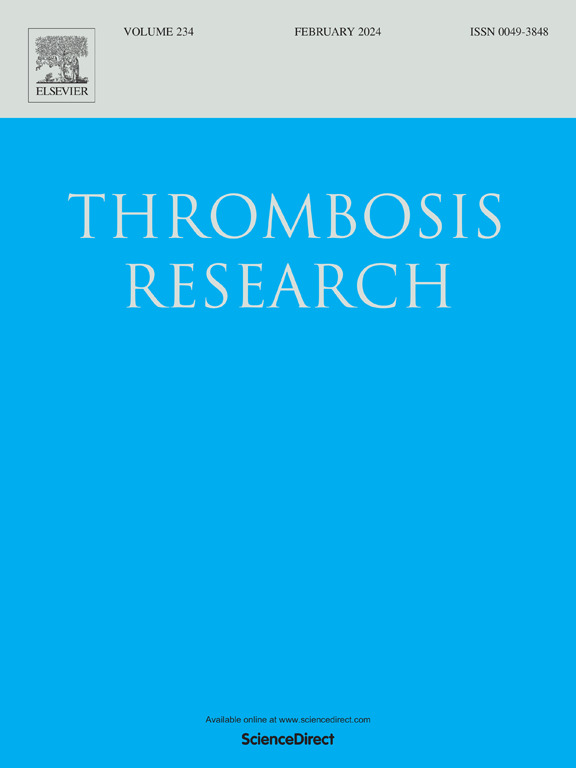Risks of major arterial and venous thrombotic diseases after hospitalisation for influenza, pneumonia, and COVID-19: A population-wide cohort in 2.6 million people in Wales
IF 3.7
3区 医学
Q1 HEMATOLOGY
引用次数: 0
Abstract
Objective
Pneumonia, influenza, COVID-19, and other common infections might increase the risk of thrombotic events acutely through an interaction between inflammation and the thrombotic system. The long-term risks of arterial and venous thrombotic events following hospitalisation for COVID-19 and hospitalisation for pneumonia or influenza are unclear.
Materials and methods
In a population-wide cohort of linked Welsh health data of adults, we calculated the incidence of arterial and venous thrombosis after hospitalisation for COVID-19 (2020−2021). We then compared this post-hospitalisation incidence with the incidence prior to COVID-19 hospitalisation in the same individuals, and with the incidence in individuals who were never hospitalised for COVID-19. We then repeated this analysis for hospitalisation for pneumonia or influenza in a separate cohort (2016–2019). We estimated adjusted hazard ratios (aHRs) in separate time periods starting from the date of the first infection that resulted in hospitalisation (day 0, 1 to 7 days, 2 to 4 weeks, 5 to 16 weeks, and 17 to 75 weeks) using time-varying Cox regression. Confounders included age, sex, smoking status, obesity, deprivation (fifths of Welsh Index of Multiple Deprivation), rural or urban setting, care home attendance, Elixhauser comorbidity index, surgery in the last year, medications (e.g. lipid-lowering and antiplatelet/anticoagulant use), hypertension and/or hypertensive medication use, and past medical history of chronic kidney disease, diabetes, chronic obstructive pulmonary disease, dementia, cancer, or any CVD.
Results
For the first arterial thrombosis, the aHRs were 3.80 (95 % CI: 2.50–5.77) between days 1–7, 5.24 (4.21–6.51) between weeks 2–4, 2.12 (1.72–2.60) between weeks 5–16, and 1.60 (1.38–1.86) between weeks 17–75 after hospitalisation for COVID-19. The corresponding aHRs after hospitalisation for pneumonia/influenza were: 5.42 (4.35–6.75), 3.87 (3.32–4.49), 1.96 (1.74–2.21), and 1.41 (1.30–1.53).
For first venous thrombosis, aHRs were 7.47 (3.56–15.7) between days 1–7, 22.6 (17.5–29.1) between weeks 2–4, 6.58 (4.98–8.68) between weeks 5–16, and 2.25 (1.67–3.02) between weeks 17–75 after hospitalisation for COVID-19. The corresponding aHRs after hospitalisation for pneumonia/influenza were: 15.1 (10.3–22.0), 11.8 (9.23–15.1), 5.80 (4.75–7.08), and 1.89 (1.57–2.29).
Excess risk was highest in individuals aged ≥60 years, in whom we estimated 2,700 and 2,320 additional arterial and 1,270 and 840 additional venous events after 100,000 hospitalisations for COVID-19 and pneumonia/influenza, respectively.
Conclusions
Both hospitalisation for COVID-19 and pneumonia/influenza increase the risk of arterial and venous thrombosis. Preventative healthcare policies are needed for cardiovascular risk factor management, vaccination, and anticoagulation in high-risk patients with hospitalised or severe infections.
因流感、肺炎和 COVID-19 住院后患重大动脉和静脉血栓疾病的风险:威尔士 260 万人口的全人群队列研究
目的肺炎、流感、COVID-19 和其他常见感染可能会通过炎症和血栓系统之间的相互作用增加急性血栓事件的风险。因 COVID-19 和肺炎或流感住院后发生动脉和静脉血栓事件的长期风险尚不清楚。材料和方法在一个由威尔士成年人健康数据组成的全人群队列中,我们计算了因 COVID-19 住院后(2020-2021 年)动脉和静脉血栓的发生率。然后,我们将住院后的发病率与同一人在 COVID-19 住院前的发病率以及从未因 COVID-19 住院的人的发病率进行了比较。然后,我们在一个单独的队列(2016-2019 年)中对因肺炎或流感住院的患者重复了这一分析。我们使用时变 Cox 回归估算了从导致住院的首次感染日期开始的不同时间段(第 0 天、1 至 7 天、2 至 4 周、5 至 16 周和 17 至 75 周)的调整后危险比 (aHR)。混杂因素包括年龄、性别、吸烟状况、肥胖、贫困程度(威尔士多重贫困指数的五分之一)、农村或城市环境、护理院就诊情况、Elixhauser 合并症指数、去年的手术、药物(如降脂药和抗血小板/抗凝血药的使用)、高血压和/或高血压药物的使用,以及慢性肾病、糖尿病、慢性阻塞性肺病、痴呆症、癌症或任何心血管疾病的既往病史。结果 对于首次动脉血栓,COVID-19住院后第1-7天的aHRs为3.80(95 % CI:2.50-5.77),第2-4周为5.24(4.21-6.51),第5-16周为2.12(1.72-2.60),第17-75周为1.60(1.38-1.86)。因肺炎/流感住院后的相应 aHRs 分别为就首次静脉血栓而言,第 1-7 天的 aHR 分别为 7.47(3.56-15.7)、22.对于首次静脉血栓形成,COVID-19住院后第1-7天的aHR为7.47(3.56-15.7),第2-4周为22.6(17.5-29.1),第5-16周为6.58(4.98-8.68),第17-75周为2.25(1.67-3.02)。因肺炎/流感住院后的相应 aHRs 分别为年龄≥60 岁者的超额风险最高,我们估计在 COVID-19 和肺炎/流感住院治疗 100,000 次后,动脉事件分别增加 2,700 例和 2,320 例,静脉事件分别增加 1,270 例和 840 例。结论因 COVID-19 和肺炎/流感住院都会增加动脉和静脉血栓形成的风险。需要制定预防性医疗保健政策,对住院或严重感染的高危患者进行心血管风险因素管理、疫苗接种和抗凝治疗。
本文章由计算机程序翻译,如有差异,请以英文原文为准。
求助全文
约1分钟内获得全文
求助全文
来源期刊

Thrombosis research
医学-外周血管病
CiteScore
14.60
自引率
4.00%
发文量
364
审稿时长
31 days
期刊介绍:
Thrombosis Research is an international journal dedicated to the swift dissemination of new information on thrombosis, hemostasis, and vascular biology, aimed at advancing both science and clinical care. The journal publishes peer-reviewed original research, reviews, editorials, opinions, and critiques, covering both basic and clinical studies. Priority is given to research that promises novel approaches in the diagnosis, therapy, prognosis, and prevention of thrombotic and hemorrhagic diseases.
 求助内容:
求助内容: 应助结果提醒方式:
应助结果提醒方式:


